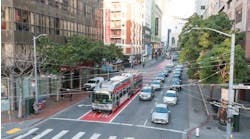Nationally, 2.6 billion trips were taken on public transportation in the third quarter of 2011, according to a report released today by the American Public Transportation Association (APTA). This is a 2.0 percent increase over the same quarter last year, representing an increase of nearly 52 million trips. Ridership in all public transportation modes increased, led by light rail which increased by 5.8 percent.
This is also the first time in three years that ridership has increased for all three quarters. The ridership increase is attributed to a number of factors including high gas prices, improved real time passenger information and a recovering economy.
"This increase in ridership shows that Americans want more transportation choices and will use public transportation if it is available in their community," said APTA President and CEO Michael P. Melaniphy. "Also, transit agency investments are paying off, resulting in riders experiencing a higher level of quality service."
Noting the important link between public transportation and the economy, Melaniphy said, "Nearly 60 percent of public transportation trips are taken for work commutes. In addition, whenever gas prices are high, people decide to save money by taking public transportation instead of driving."
2011 Third Quarter Ridership Breakdown
Nationally, heavy rail ridership increased by 2.0 percent. Thirteen out of 15 heavy rail systems (subways and elevated trains) experienced ridership increases in the third quarter of 2011 over the same period in 2010. Cities with heavy rail systems showing the highest percentage of increases were located in the following cities: Cleveland, Ohio (9.7 percent); Philadelphia, Pa. (8.7 percent); Boston, Mass. (7.0 percent); and San Francisco, Calif. (6.1 percent).
Twenty-two out of 27 light rail systems reported an increase in ridership for the third quarter of 2011. Overall, light rail increased by 5.8 percent in the third quarter of 2011. Light rail systems in six cities saw double digit increases in the third quarter: Dallas, Texas (36.4 percent); Seattle, Wash. – King County Department of Transportation (35.8 percent); Salt Lake City, Utah (21.0 percent); Buffalo, N.Y. (19.5 percent); Oceanside, Calif. (16.0 percent); and Philadelphia, Pa. (10.0 percent). Other light rail systems showing significant percentage of increases were located in the following cities: Seattle, Wash. – Sound Transit (8.3 percent); Phoenix, Ariz. (7.8 percent); and Los Angeles, Calif. (7.6 percent).
Twenty-two out of 27 commuter rail systems reported ridership increases and overall commuter rail increased by 2.7 percent. Austin, Texas (Capital Metropolitan Transportation Authority) saw triple digit increases in the third quarter due to added mid-day service, more reverse commute trips and offering more peak trips at all nine stations. In the third quarter of 2011, the following six cities saw double digit increases: Nashville, Tenn. (30.2 percent); Oceanside, Calif. (22.7 percent); Portland, Ore. (16.2 percent); Seattle, Wash. (11.8 percent); San Carlos, Calif. (10.7 percent); and Salt Lake City, Utah (10.1 percent).
Bus ridership increased nationally by 1.4 percent. The following two cities had double digit increases in the third quarter: Columbus, Ohio (10.8 percent); and St. Louis, Mo. (10.3 percent). Other ridership increases for large bus agencies were: Long Beach, Calif. (9.3 percent); San Antonio, Texas (7.7 percent) Miami, Fla. (7.3 percent); Orlando, Fla. (6.8 percent); San Diego, Calif. (6.7 percent); Washington, D.C. (5.7 percent); Arlington Heights, Ill. (5.4 percent); Minneapolis, Minn. (5.4 percent); and Cleveland, Ohio (5.2 percent).
Demand response (paratransit) increased in the third quarter of 2011 by 2.6 percent. Trolleybus ridership increased by 3.2 percent.
To see the complete APTA ridership report go to: http://www.apta.com/resources/statistics/Documents/Ridership/2011-q3-ridership-APTA.pdf

